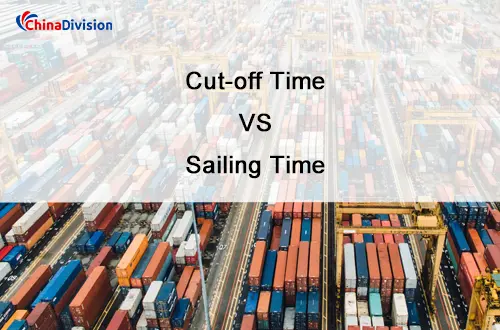Relationship Between Ocean Shipping Cut-off Time and Sailing Time
Cut-off time and sailing time are two core concepts that influence the entire shipping plan. Although they sound similar, their actual meanings and operational implications are completely different. Accurately understanding the relationship between these two is crucial for B2B businesses and e-commerce sellers to control logistics timeliness and avoid additional costs. Misunderstanding these two terms can lead to missed shipments, delays, and additional costs.
Table of Contents
In this guide, Chinadivision will explain the difference between cut-off time and sailing time, explore the key factors that influence them, and answer frequently asked questions to ensure smooth global shipping operations.
What are ocean shipping cut-off time and sailing time?

Cut-off time (ocean shipping cut-off time)
Cut-off time refers to the deadline by which cargo must arrive at the port terminal and all shipping documents (such as bills of lading and customs clearance) must be completed. This is the "last cut-off time" before sailing. Missing this cut-off means your cargo will not be able to board the scheduled vessel and will be delayed until the next sailing.
Key Points:
Set by the shipping line or terminal. It varies depending on the port, carrier, and service type (FCL/LCL). It includes cargo inspection, documentation, and loading time.
Common cut-off times include:
Terminal Cut-off Time: The latest time cargo must arrive at the terminal.
Customs Declaration Cut-off Time: The latest time customs declaration must be submitted.
VGM Cut-off Time: The deadline for submitting the Verified Gross Mass (VGM).
Failure to meet this deadline will prevent cargo from boarding the vessel and will result in delayed delivery and potential incurring additional storage or order modification fees.
Ocean Shipping Departure Time
The departure time is the scheduled departure time of the vessel from the port. Unlike air freight, ocean freight has a fixed schedule, but delays can occur due to weather, port congestion, or operational issues. It is usually between 12 and 48 hours after the customs cut-off time. This time is usually determined by the shipping company and published in the sailing schedule. The sailing time is the starting point for calculating transportation time. For example, "Sea freight to the US West Coast typically takes 15-20 days" is calculated from the sailing time.
Key Points:
It is published in the sailing schedule but is subject to change. This can affect transit time to the destination port. Delays can affect supply chain timelines.
How is the cut-off time related to the sailing time?
The customs cut-off time is the threshold for boarding the vessel, while the sailing time is the result of on-time departure. The cut-off time always precedes the sailing time because:
Cargo must be loaded before the vessel departs. Required documents for customs and port clearance must be obtained. The shipping company needs time to finalize the manifest and vessel loading plan.
Different Responsibilities
Cut-off time is more related to the shipper/forwarder's operations (such as delivery, customs clearance, and document submission).
Sailing time is controlled by the shipping company and cannot be manipulated by the shipper.
Different Impacts
Missing the Cut-off Time → Cargo Unable to Board the Vessel → Risk of Delay + Additional Costs
Missing the Sailing Time (generally impossible to miss on purpose) → Changes to the entire shipping schedule, impacting all shippers.
Factors Affecting Cut-off Times
Port Efficiency
Busy ports may require earlier cut-off times to alleviate congestion and relieve pressure on the yards and gates.
Cargo Type
Cut-off times for dangerous goods or refrigerated containers may be more stringent.
Customs Clearance
Documentation delays may lead to last-minute changes.
Shipping Company Policies
Different shipping companies have different cut-off time regulations; some are strict, while others may be somewhat flexible (e.g., the ability to request a delayed cut-off).
Holiday and Seasonal Factors
China's National Day, Spring Festival holidays, and the period before Christmas in Europe and the United States are traditionally peak shipping periods, often leading to tighter cut-off times.
Documentation and VGM Submission
Incorrect customs documentation or failure to submit the VGM on time can result in cargo being refused loading even upon arrival.
Weather and Traffic
Extreme weather or traffic congestion around the port can cause delivery delays, impacting the cut-off time.
Factors Affecting Sailing Time
Weather Conditions
Storms or rough seas may delay departures.
Port Congestion
Extended waiting times at anchor may delay sailings.
Operational Issues
Mechanical failure or crew shortages may cause delays.
Transshipment Schedules
If cargo must be transshipped at a hub port, sailing times depend on the transshipping vessel.
FAQs and Expert Answers
What happens if the cut-off time is missed?
The cargo will be rolled over to the next available sailing, incurring demurrage (port storage fees) and potential late delivery penalties. To avoid this, work with a reliable freight forwarder like Chinadivision to ensure timely submission.
What is the difference between the cut-off time and the documentary cut-off time?
Cargo cut-off time – The last date/time the cargo is actually delivered to the terminal.
Documentary cut-off time – The deadline for submitting shipping documents (e.g., bill of lading, commercial invoice).
Missing either of these can cause cargo delays.
Is the "Sailing Time" listed by the shipping company absolutely accurate?
Not necessarily. Vessels may be delayed due to weather, port congestion, and other factors, but shipping companies generally bear no liability for breach of contract.
If you miss the customs cut-off time, is there any other way to board the ship?
Sometimes, you can buy time by applying for a "delayed customs cut-off" or using "urgent customs clearance services," but this isn't guaranteed and usually incurs additional fees. If you truly can't make it, Chinadivision can help you prioritize the next available vessel and optimize documentation processes to minimize the impact of delays.
Why choose Chinadivision for your ocean logistics?
At Chinadivision, we not only provide traditional ocean freight services but also prioritize full visibility and timeliness:
Precise timeliness management: By integrating data from major shipping companies, we monitor vessel schedules and customs cut-off times in real time and proactively alert customers to critical milestones.
Professional customs clearance and documentation teams: Ensure the customs declaration, VGM submission, and other processes are completed on a single pass, avoiding human-induced delays.
Emergency response mechanisms: Provide quick solutions to address unexpected customer needs and minimize losses.
Suitable for e-commerce and B2B businesses: Supports both full container load (FCL) and less-than-container load (LCL), covering major trading regions. By understanding the key differences and connections between cut-off times and sailing times, businesses can better manage ocean freight logistics, reduce costly delays, and succeed in global trade.
From first-leg ocean freight, customs clearance and delivery, to global e-commerce warehousing and distribution, Chinadivision provides professional, reliable, and efficient international transportation services. If you have strict shipping time requirements or would like to further optimize the responsiveness of your global supply chain, please contact us for customized logistics solutions.





